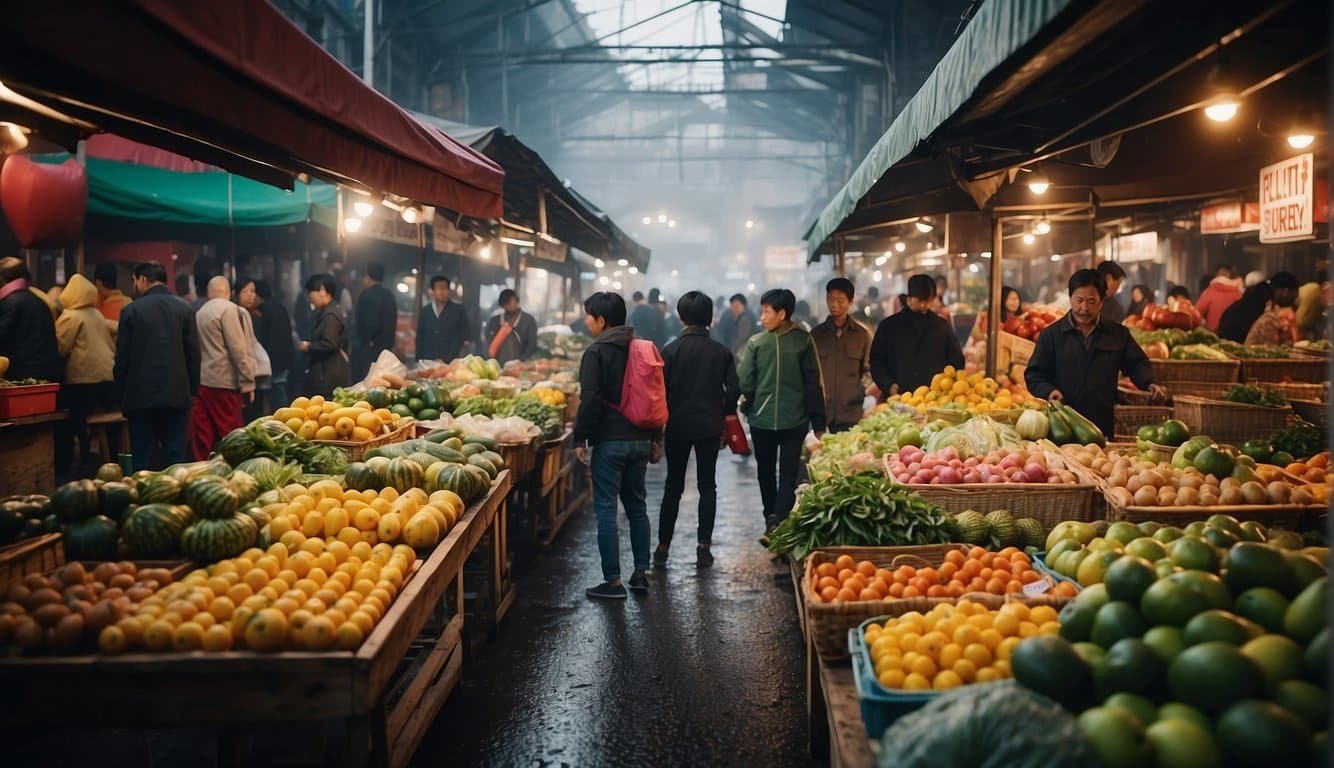Overview of Wet Markets

Wet markets are buzzing hives of activity where shoppers can find a plethora of foods ranging from fresh vegetables to live animals, making them a cornerstone of daily nutrition for many people worldwide.
Defining Wet Markets
A wet market is a marketplace selling fresh produce and live animals, often including meat, fish, and poultry, which are typically slaughtered on-site. The term ‘wet’ signifies that these markets tend to be moist due to the constant use of water to wash floors, keep fruits and vegetables fresh, and maintain a clean environment for fresh seafood. These markets differ from ‘dry markets’ which sell non-perishable goods such as grains and household products.
The Role in Food Supply
Wet markets play a vital role in the food supply chain, particularly in many Asian and African cities. They are essential for the distribution of fresh produce, including fruits and vegetables, that locals rely on for their daily sustenance. Additionally, wet markets often serve as a primary source of fresh meat and seafood, catering to the preferences of consumers seeking a variety of freshly-slaughtered meats and live fish. These markets are not only crucial for food security but also for the culinary traditions that define regional cuisines.
Health and Safety Concerns
Wet markets are often vibrant hubs of activity where a wide array of food items, including fresh produce and live animals, are sold. While they are cultural cornerstones in many parts of the world, health and safety concerns, particularly regarding the spread of diseases, have brought them to the attention of public health officials.
Disease Transmission Risks
The close proximity of live animals and fresh produce in wet markets creates an environment where zoonotic diseases can transfer from animals to humans. Since wet markets sell different species of live animals, they can serve as melting pots for these viruses, including strains of avian influenza and coronavirus. Notably, past outbreaks of SARS and MERS have been associated with such markets. The emergence of COVID-19 has heavily underscored the potential risks, as public health officials investigate the origins of the virus, with some suggesting a possible link to a wet market.
Regulations and Health Standards
Health standards and regulations are critical in minimizing the risks associated with wet markets. However, differences in legal frameworks and enforcement can lead to varying hygiene conditions across these markets. Food safety is a significant concern, as improper handling of meat and seafood can lead to cross-contamination and outbreaks. While some markets operate legally and adhere to safety practices, others may function without the same level of regulatory oversight, sometimes selling illegal wildlife and contributing to public health concerns. It is essential for health officials to continuously develop and enforce standards aimed at improving wet market conditions globally.
Socioeconomic and Environmental Impact

Wet markets, often bustling with a variety of wild species, play a complex role in society touching everything from biodiversity to human culture. While these markets can be a hotspot for cultural exchange and economic activity, they also bring forth significant concerns regarding environmental health and the potential for pandemics.
Wildlife and Biodiversity
Wet markets have been a critical part of the global wildlife trade supply chain, supporting livelihoods but also contributing to the decline of biodiversity. Wildlife markets sell a variety of wild animals, sometimes including endangered species, which can put pressure on wildlife populations. The high animal density in these markets, coupled with the presence of wild animals, increases the risk of disease transmission, which can sometimes jump species barriers, potentially leading to outbreaks.
Market Operations and Culture
The operations of wet markets are deeply entwined with local culture and societal norms, providing fresh food and supporting the social fabric of communities. However, these markets have also faced criticism and calls for stricter regulation or bans, due to the environmental impacts and the role they can play in the spread of zoonotic diseases. There is a balance to be struck between preserving cultural practices and ensuring public health safety, especially in the wake of a pandemic. Additionally, conversations and policies around wet markets have sometimes exacerbated xenophobia and anti-Asian sentiment, highlighting the need for sensitive dialogue and solutions that don’t perpetuate discrimination.

